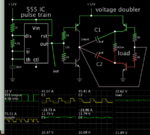lerameur
Junior Member level 1

Hello everyone,
I have a circuit with one 150watt mosfet
If I want to double the current load, is it better to parallel the mosfet ?
OR use a 300watt rated mosfet ?
Also dont get that a Mosfet can be rates at 150W or 300W or event 600W, and all thre have the same size and (TO 220)
Sure the heatsink need to be selected accordingly, It this a normal situation with mosfets in general?
ken
I have a circuit with one 150watt mosfet
If I want to double the current load, is it better to parallel the mosfet ?
OR use a 300watt rated mosfet ?
Also dont get that a Mosfet can be rates at 150W or 300W or event 600W, and all thre have the same size and (TO 220)
Sure the heatsink need to be selected accordingly, It this a normal situation with mosfets in general?
ken




